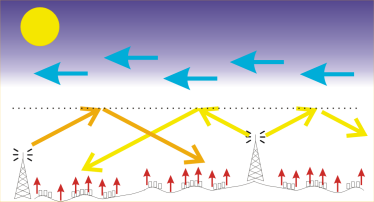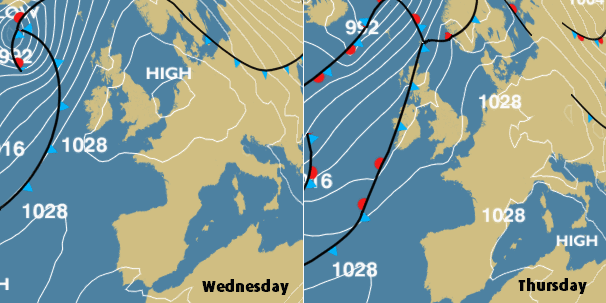High pressure causing channel loss through "Inversion"
 Brian Butterworth published on UK Free TV
Brian Butterworth published on UK Free TV There is high pressure over the whole of the UK at the moment, and this causes the Inversion Effect. This is causing people to be missing a single Freeview multiplex, or have terrible analogue reception on a single channel. The problem may come-and-go or last for several days.

For details, please see What is the Inversion Effect and why does it effect my Freeview TV reception?.

Help with Freeview, aerials?
Saturday, 4 January 2020
T
TK11:42 PM
Colchester
What would be really useful is to know the signal path and transgressing distant Freeview region signal so we could feasibly alter our aerial array to null out as much of the interfering signal as possible in the hopes of still receiving a signal with *enough* integrity from the local transmitter... I find it astounding that an entire set of local multiplexes can be obliterated by a single distant regions set of multiplexes! Did Freeview not consider the folly of placing multiplexes on the same UHF Channels/Frequencies across regions that have been known to suffer co-channel interference. They could have ensured at least ONE multiplex remains unmolested by the out of region transmitter! In my experience Areal erectors spend all their time maximising signal strength from the local transmitter and that's it... no consideration is given to the fact that DVB-T/T2 does not provide any picture improvement or stability once the signal reaches a certain signal level and quality threshold. The aerial orientation should be optimised to reject temperature inversion based long distance propagation while still providing a reliable local signal to reduce the impact of out of region co-channel interference.
It *should* be well known by industry experts what regions will interfere in any given atmospheric conditions and therefore there should be a database or map compiled for what regions are likely to interfere with any other given region based upon many decades of research going back through last century... after all the same propagation occurs to both analogue and DVB-T/T2 signals at any specific frequency.
This chuck it up and point it at the transmitter mast and get the strongest signal possible is not good enough to deal with sporadic overwhelming temperature inversion based propagation and Freeviews poor regional multiplex allocations.
| link to this comment |
TK's: mapT's Freeview map terrainT's terrain plot wavesT's frequency data T's Freeview Detailed Coverage
Sunday, 5 January 2020
C
Chris.SE6:43 AM
TK:
Well that might sound a nice idea, I'm afraid it's a total none starter. Apart from aerial beam-widths etc. not being narrow enough, the source of the interfering signals during tropospheric propagation could come from anywhere. The distance such signals could travel will depend on the extent of the inversion layer as well as it's height. You can't exactly predict those factors. The signals could come from any where in Europe (even further afield) not just the UK, and from any direction, so it's not just distant "regions".
Channel sharing has always been the case, even in B&W analogue days. The allocation of channels for the various transmitters has been carefully worked out along with transmitter power and radiation patterns so that in typical conditions there is no co-channel interference (that includes our nearest neighbours such as France, Holland, Belgium and Ireland).
There's over 1100+ transmitters in the UK alone, of which 80+ are main transmitters (90+ transmitting the 6 main muxes).
| link to this comment |
Monday, 6 January 2020
T
TK3:58 AM
Colchester
Chris.SE: Well yes and no... If it's coming from the rear or the array then one just needs to find a null point in the polar pattern and null out the rear signal and get it away from one of the spurious rear lobes. If there is polarisation twist then one should be able to null out the interfering co-channel off horizontal but not vertical signal by setting the array to perpendicular to the co-channel off horizontal but not vertically polarised signal and because there is significant acceptance off perpendicular the original horizontally polarised signal will be favoured over the null twisted originally horizontally polarised signal. In addition IF the interfering co-channel signal is arriving at receiving array at a different vertical incident angle then one should be able to aim the array away from that angle and past the desired signals optimum point so the co-channel signal may be at say the -12dB to -20dB point or greater in the array and the desired local transmitter signal may be -1dB to -3dB still a plenty strong enough local signal but significantly reducing the acceptance of the interfering co-channel signal. Of course IF the atmospheric propagation manages to arrive on exactly the same polarisation and incident angle AND bearing as the locally transmitted signal then I agree it should be a non-starter but from what I have learned over the past few decades I believe it's very rarely ever that since there is always some polarity skew through tropospheric ducting as I learnt it... Of course not all education of the past has turned out to be true in reality but I have no indication that the fact is incorrect.
Not all the transmitters can possibly interfere via tropospheric ducting since not all are in line with the a decent gain lobe on the array and so will be rejected, ALL the Freeview lite and other dead spot transmitters are V polarisation and tiny ERP so could not interfere... Not to forget that transmitters on different even adjacent channels will not interfere like they did on PAL analogue standard. What I found strange last night and to some extent tonight is the Sudbury multiplex broadcast on UHF channel 37 was and still is experiencing co-channel interference and did fall to no signal for several hours it's now at around 7% quality when it is normally at 100% quality... one of the other multiplex is very slightly down on quality 85% but not noticeable when watching the rest are apparently untouched in the high 80% signal strength and 100% quality yet not a single out of region multiplex is detected on any of the channels that are not in use by the local Sudbury transmitter... I guess that is suggesting an out of UK signal on UHF ch37 that is not in a compatible modulation scheme to UK DVB-T/T2 is the cause! It is a non-analogue TV signal as nothing is detected at that frequency using ATV manual scan... I find it difficult to believe nothing can be done to mitigate any of these tropospheric ducting problems. Much of it is understood quite well, but digital receivers make it difficult to fine tune aerial array alignment to favour one signal over another on the same bandwidth... Just for a test using the 602MHz compromised Sudbury multiplex ... not being able to use my normal large log periodic array as it's communally shared by other flats in the building I dug out an old set top 3 director one reflector aerial and determined the interfering signal is coming from Europe using an incompatible modulation so our DVB-T2 receivers will not demodulate and decode it... and the polarisation was originally Horizontal and had been skewed such that by adjusting my aerial OFF horizontal to the 10 past 8 angle as opposed to 15 past 9 standard my receiver was able suppress some of the back end Euro signal enough for the local NNW Sudbury signal to be resolved and scanned. OK this is not a conclusive test but it does suggest to me that it is possible on an individual basis to optimise aerial array placement to reject certain sources of interference by adjustment in real-time. It is unlikely that a single position would be found that would cater to all sources of tropospheric propagated signals but the ability to rotate in 3 axis an array could mitigate many incidences of such co-channel interference enough to let the encoded FEC to produce a watchable view-able DVB-T2 signal.
Also found that I am currently receiving PSB1 and PSB2 from Dover (Kent) on this old indoor aerial just clean enough to search and find the channels on them manually with a polarity skew of a few degrees off horizontal, no doubt if I had a 20+ element log-periodic outside on a rotating mount I could probably watch it and get the other lower power MUX's at the moment too but those are not the interfering out of area transmissions as they are all on non-conflicting channels with Sudbury MUX's Just got a 84% signal strength on Sudbury CH37 MUX using the indoor tiny aerial and 100% quality compared to 50% signal strength and 82% quality on loft 24 element log periodic originally aligned for optimum clear of atmospheric interference as advised by Arial erector experts. To me that is proof of concept... both aerials are using same branded same gain and noise specs distribution amplifiers just for fairness. 100% quality and practical rejection of the rear EU signal was achieved when pointing the aerial downward around 10 degrees off horizontal but facing towards Sudbury this allowed near perfect reception of the MUX that was not at no signal but was less than optimal quality and signal strength due to co-channel interference from a rear'ish out of region tropospheric tunnelled signal.
| link to this comment |
TK's: mapT's Freeview map terrainT's terrain plot wavesT's frequency data T's Freeview Detailed Coverage
Friday, 23 May 2025
Why have I lost most freeview channels in Dawlish, I have re
set and done auto freeview tuning but only get 10 channels, no ITV, ch4
| link to this comment |
Saturday, 24 May 2025
C
Chris.SE4:11 AM
Jane Harris:
There's a number of reasons that could cause this disruption to signals BUT your "mistake" I'm afraid was to try and retune, you were obviously correctly tuned to start with! You cannot tune to signals that aren't there or cannot be decoded, the usual result is to clear the correct tuning the you have no idea when the signals have returned to normal,
Weather conditions are one possibility, Freeview issued a warning as did the BBC who updated theirs this week -
https://www.bbc.co.uk/rec…2025
Updates and alerts | Freeview
There's also links to explanations of this weather phenomenon at the top of this page as well as my previous post here.
The transmitter you get your signals from may be having engineering work.
You may be getting interference from a new/upgraded mobile phone mast for which you'd be able to get a Free filter to block such signals.
As you haven't given a full postcode we can't advise on either of those two.
Have you had a postcard from Restore TV?
Obviously a fault on your aerial installation could be the cause, have you checked that your aerial looks intact and is still pointing correctly and that the downlead isn't flapping in the wind?
If you provide your full postcode we that then give some constructive advise on these.
| link to this comment |
Select more comments
Your comment please!